
First, you should try to reduce symptoms according to the lifestyle guidance and with drug therapy. If the condition does not improve with these therapies, or if you have a grade Ⅲ or higher prolapse symptom according to the Goligher Classification that divides the symptoms of hemorrhoids (piles) into 4 grades, a surgery may be performed depending on the decision of your primary doctor based on each pathology or your (the patient's) intention.
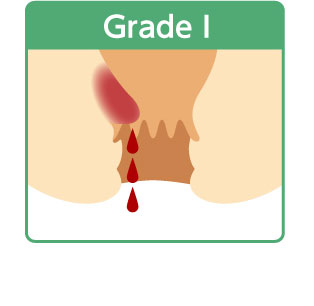
Initial stage: There is no prolapse of hemorrhoids and no pain. Bleeding occurs while having a bowel movement.
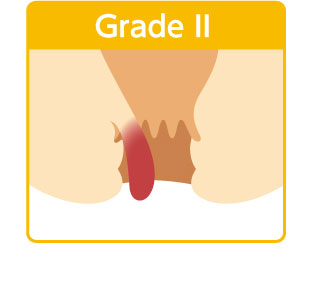
A hemorrhoid prolapses at the time of a bowel movement but returns into the anus spontaneously.
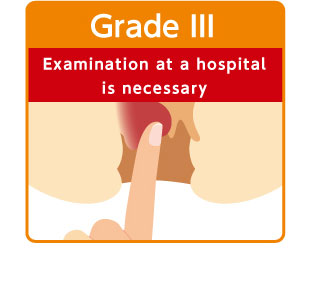
It prolapses and does not return without pushing it back with the fingers.
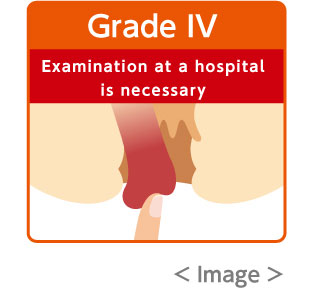
It does not return into the anus even if it is pushed back with the fingers. Mucus often oozes. Pain and bleeding disappear. Always have itching or discomfort.
The following five major surgical treatments are currently available for hemorrhoids (piles) .1)
The procedure may vary depending on the primary doctor in terms of detailed methods or procedures, or there may be other procedures. Therefore, they are just references.
(1) Ligation and excision
(2) Rubber band ligation technique
(3) Stapled hemorrhoidopexy (PPH method)
(4) Divided ligation of hemorrhoid
(5) Sclerotherapy
Incise the skin with internal hemorrhoids (internal piles) and peel the wart (hemorrhoid) toward the inside of the anus, not to damage the internal anal sphincter, which closes the anus. Then, the root of the wart (hemorrhoid) is tightly tied to avoid bleeding, and the wart (hemorrhoid) is removed.
The image below illustrates a semi-closed system in which the incision site is half closed. There are several other methods for closing the incision site.
< If hemorrhoids (piles) are present at 3 common sites >
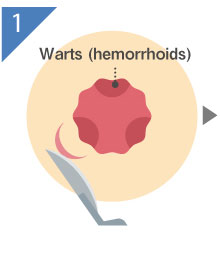
Before surgery. Three warts (hemorrhoids) prolapse.
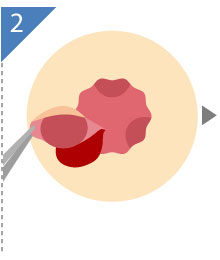
Incise the skin and peel the warts (hemorrhoids) little by little from the outside.
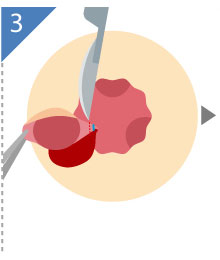
Tie the vessel tightly at the root of the wart (hemorrhoid) and remove the wart (hemorrhoid).
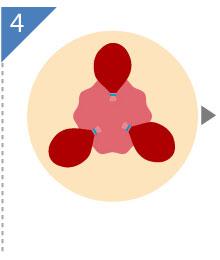
A condition in which all warts (hemorrhoids) were removed.
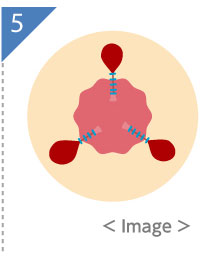
Suture the incised anal skin (semi-closed).
One of the therapies without using a scalpel. In this method, the root of the wart (hemorrhoid) is tied with a rubber band tightly to stop blood flow, which results in necrosis and shedding of the wart (hemorrhoid). It is said that this method cannot be used for large internal hemorrhoids (internal piles) that are too big to attach a rubber band or for external hemorrhoids (external piles) where you may feel pain.


Tie the root of the internal hemorrhoids (internal piles) with a rubber band.
The warts (hemorrhoids) where blood circulation was cut off with a rubber band will be necrotized in 1 to 2 weeks. They will fall off with the rubber band and be excreted with stool.
A dedicated instrument for treatment of hemorrhoids and prolapsed anus is used. A cylindrical device is inserted into the anus, and the loose rectal mucosa is sandwiched in the cylinder. Then, the rectal mucosa is cut into round slices of approximately 2 cm wide and resected. Then, that makes sure not to prolapse the wart (hemorrhoid) by anastomosing the upper and lower parts and lifting up the internal hemorrhoids (internal piles).
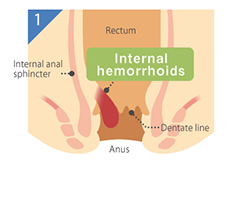
Internal hemorrhoids sagging over the dentate line
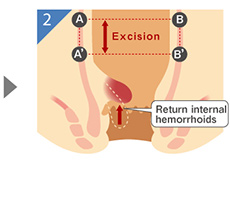
Place the loose rectal mucosa inside the instrument, return the internal hemorrhoid to the original position, resect the rectal mucosa above the internal hemorrhoid approximately 2 cm in a cylinder, and suture the resected upper and lower mucosa (AA', BB').
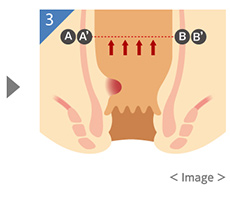
The internal hemorrhoids that have passed the dentate line return to the original position when it was pulled on the rectum sutured with AA'BB '.
It is the method also called classic hemorrhoid ligation.
It makes the wart (hemorrhoid) prolapsed after injection of local anesthetic, and passes a needle with double thread through the root of the wart. Then, pull the two threads in the opposite direction and tie the root of the wart (hemorrhoid) tightly to inhibit blood flow. The wart (hemorrhoid) whose blood flow has stopped will be necrotic and fall off in approximately 10 days.
It is said that the method can widely treat internal and external hemorrhoids (internal and external piles).
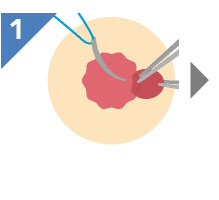
It prolapses the wart (hemorrhoid) out of the anus and pulls it out so that the roots can be seen.
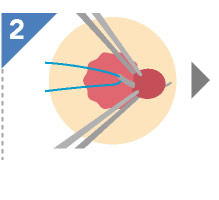
Then, pass a needle with two threads through the pulled-out wart (hemorrhoid) outward from the inside of the anus.
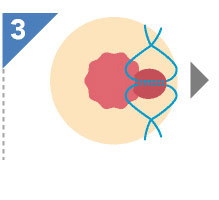
Divide the two threads in opposite direction of each other
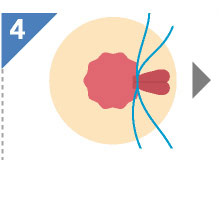
Tie the root of the wart (hemorrhoid) tightly with each thread.
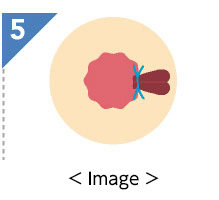
Blood flow is blocked, and the wart (hemorrhoid) is necrotized and falls off.
It is a method that hardens and shrinks the wart (internal hemorrhoid) by injection of the internal hemorrhoids (internal piles), includes ALTA therapy and 5% PAO sclerotherapy.
[Reference]
1) Guidelines for Diagnosis and Treatment of Anal Diseases and Rectal Prolapse 2020
2) Easy-to-Understand the Latest Medicine New Edition Hemorrhoids: Hirata Masahiko
3) Rectal and Anal Diseases that should not be overlooked Atlas of "Buttocks Diseases": Inatsugi Naoki